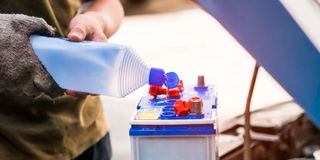Premium
Is drinking water safe for my car battery?

Distilled water specifically removes all minerals, but it might not be packaged to the hygiene standards legislated for “human consumption”.
What you need to know:
- Drinking distilled water is better for your body than serious dehydration, and topping up your battery with drinking water is better than letting it run dry.
- Bottled drinking water is carefully sanitised (no germs) but it contains lots of minerals which are beneficial to human health.
Can you safely drink distilled water used for battery top-ups, and can you use bottled drinking water to top up your battery? “Thirsty-for-knowledge”
If necessary, the two are interchangeable. In an emergency. Drinking distilled water is better for your body than serious dehydration, and topping up your battery with drinking water is better than letting it run dry.
But while both are ostensibly very clean water, they are also significantly different. Bottled drinking water is carefully sanitised (no germs) but it contains lots of minerals which are beneficial to human health.
However, these same minerals will progressively shorten the life of your battery by polluting or obstructing the chemistry between the electrolyte and the plates.
Distilled water specifically removes all minerals, but it might not be packaged to the hygiene standards legislated for “human consumption”.
It will also taste rather bland. Rainwater will not have significant mineral content or germs on first arrival, but it will not be absolutely pure H2O, having collected some chemistry and particulates from the atmosphere on its journey from cloud to puddle.

The tops of the battery plates should always be slightly submerged, and never in the open air at the top of the battery case.
Most commonly, it will be a very dilute nitric acid. Safe to drink if your harvesting conditions are clean; and a viable stand-by for your battery if fully distilled water is urgently needed but not available.
The tops of the battery plates should always be slightly submerged, and never in the open air at the top of the battery case. The max-min lines on the case are your guide.
To further quench your thirst for knowledge, “distillation” has been known for several thousand years as a process of heating up a compound until its chemical components start to physically separate, to either remove undesirable elements or to concentrate desirable ones.
In the case of salty sea water, for example, boiling generates steam which can be captured and condensed (by cooling) to achieve almost completely pure H2O. The salt remains in the boiling pot. The first “modern” scientist to describe the process was Aristotle, who would this year celebrate his 2,407rd birthday.





